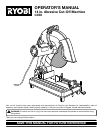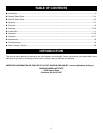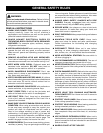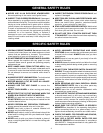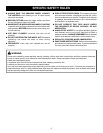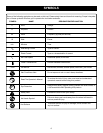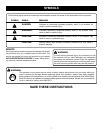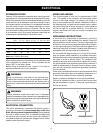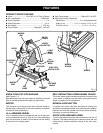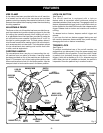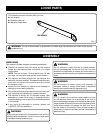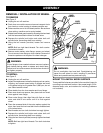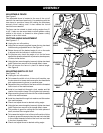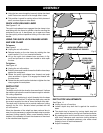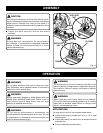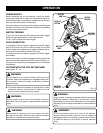
5
SPECIFIC SAFETY RULES
n ALWAYS EASE THE ABRASIVE WHEEL AGAINST
THE MATERIAL when starting to cut. A harsh impact
can break the wheel.
n BEFORE CUTTING press the trigger switch and allow
the cut-off wheel to reach full speed.
n MAKE SURE THE WORK AREA HAS AMPLE LIGHTING
to see the work and that no obstructions will interfere with
safe operation BEFORE performing any work using your
cut-off machine.
n USE ONLY FLANGES furnished with this cut-off
machine.
n DO NOT OVERTIGHTEN THE WHEEL NUT. Excessive
tightening can cause the whee to crack during
operation.
n FREQUENTLY clean dust from beneath the cut-off
machine.
n RISK OF FIRE OR EXPLOSION. This product has parts
such as snap switches, receptacles, and the like, which
tend to produce arcs or sparks. Therefore, when located
in a garage, the machine should be 18 in. above the floor
and located in a separate room.
n DO NOT OPERATE THIS TOOL WHILE UNDER
THE INFLUENCE OF DRUGS, ALCOHOL, OR ANY
MEDICATION.
n ALWAYS STAY ALERT! Do not allow familiarity (gained
from frequent use of your cut-off machine) to cause a
careless mistake. ALWAYS REMEMBER that a careless
fraction of a second is sufficient to inflict severe injury.
n REPLACE A CRACKED WHEEL IMMEDIATELY.
n SAVE THESE INSTRUCTIONS. Refer to them frequently
and use them to instruct other users. If you loan someone
this tool, loan them these instructions also.
WARNING:
Some dust created by power sanding, sawing, grinding, drilling, and other construction activities contains chemicals
known to cause cancer, birth defects or other reproductive harm. Some examples of these chemicals are:
• lead from lead-based paints,
• crystalline silica from bricks and cement and other masonry products, and
• arsenic and chromium from chemically-treated lumber.
Your risk from these exposures varies, depending on how often you do this type of work. To reduce your exposure to
these chemicals: work in a well ventilated area, and work with approved safety equipment, such as those dust masks
that are specially designed to filter out microscopic particles.



